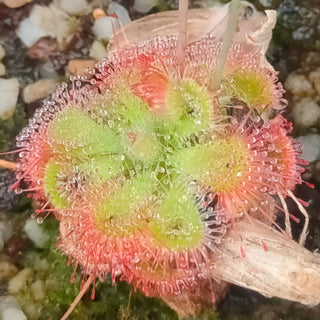Cleome serrulata
ROCKY MOUNTAIN BEE PLANT, SPIDER FLOWER
- Unit price
- / per
Cleomella serrulata (syns. Cleome serrulata and Peritoma serrulata), is commonly known as Rocky Mountain beeplant/beeweed, stinking-clover, or bee spider-flower. Many species of insects are attracted to it, especially bees, which helps in the pollination of nearby plants. It is native to southern Canada and the western and central United States.
Cleomella serrulata is an annual plant growing to 10-150 cm (4-59 in) tall, with spirally arranged leaves. The leaves are trifoliate, diminutive teeth, and with three slender leaflets each 1-7 cm (0.5-3 in) long. The flowers are reddish-purple, pink, or white, with four petals and six long stamens. Flowering lasts an extended period because it begins at the bottom of the stalk and works its way up. The onset of flowering and seed pods comes at the same time.
Moisture, temperature, and time are critical in seed germination. Germination occurs during summer and plants can quickly grow to 1-2 meters (3.3-6.6 ft). Flowers are often covered with a variety of insects, especially bees.
Cleomella serrulata is native in southern Canada from British Columbia to Ontario and in the United States from the west coast of the United States east to Ohio and southwest to Texas. It is also naturalized farther east in North America including Maine. This species is often found in disturbed lands-such as roadsides, open woods, mountain foothills, and prairies. The plants prefer moist alkaline soils that are light or sandy. It grows in a wide range of pH levels and prefers mild shade or full sun while being drought tolerant.
Type: Annual that readily self-seeds for future seasons
Height: 40", 100cm
Location: Sun
Seeds per packet: 20
Sow just under the surface of the soil and water in. Leave them at room temperature for 6 weeks. This helps break the phytohormones which inhibit germination. They will not grow yet. Then a cooling period is required. Cover them with plastic and place in a fridge for 80 days. Be sure they stay moist. After the cold stratification period they are then brought back to a cool room (15-18C, 59-68F) for them to germinate. Germination can be erratic, generally 30-90 days after the warming period for most seeds, though some can take longer.
Cleome serrulata
ROCKY MOUNTAIN BEE PLANT, SPIDER FLOWER
- Unit price
- / per
Multiple secure payment options available.
Adding product to your cart
You may also like
Cleomella serrulata (syns. Cleome serrulata and Peritoma serrulata), is commonly known as Rocky Mountain beeplant/beeweed, stinking-clover, or bee spider-flower. Many species of insects are attracted to it, especially bees, which helps in the pollination of nearby plants. It is native to southern Canada and the western and central United States.
Cleomella serrulata is an annual plant growing to 10-150 cm (4-59 in) tall, with spirally arranged leaves. The leaves are trifoliate, diminutive teeth, and with three slender leaflets each 1-7 cm (0.5-3 in) long. The flowers are reddish-purple, pink, or white, with four petals and six long stamens. Flowering lasts an extended period because it begins at the bottom of the stalk and works its way up. The onset of flowering and seed pods comes at the same time.
Moisture, temperature, and time are critical in seed germination. Germination occurs during summer and plants can quickly grow to 1-2 meters (3.3-6.6 ft). Flowers are often covered with a variety of insects, especially bees.
Cleomella serrulata is native in southern Canada from British Columbia to Ontario and in the United States from the west coast of the United States east to Ohio and southwest to Texas. It is also naturalized farther east in North America including Maine. This species is often found in disturbed lands-such as roadsides, open woods, mountain foothills, and prairies. The plants prefer moist alkaline soils that are light or sandy. It grows in a wide range of pH levels and prefers mild shade or full sun while being drought tolerant.
Type: Annual that readily self-seeds for future seasons
Height: 40", 100cm
Location: Sun
Seeds per packet: 20
Sow just under the surface of the soil and water in. Leave them at room temperature for 6 weeks. This helps break the phytohormones which inhibit germination. They will not grow yet. Then a cooling period is required. Cover them with plastic and place in a fridge for 80 days. Be sure they stay moist. After the cold stratification period they are then brought back to a cool room (15-18C, 59-68F) for them to germinate. Germination can be erratic, generally 30-90 days after the warming period for most seeds, though some can take longer.
























































